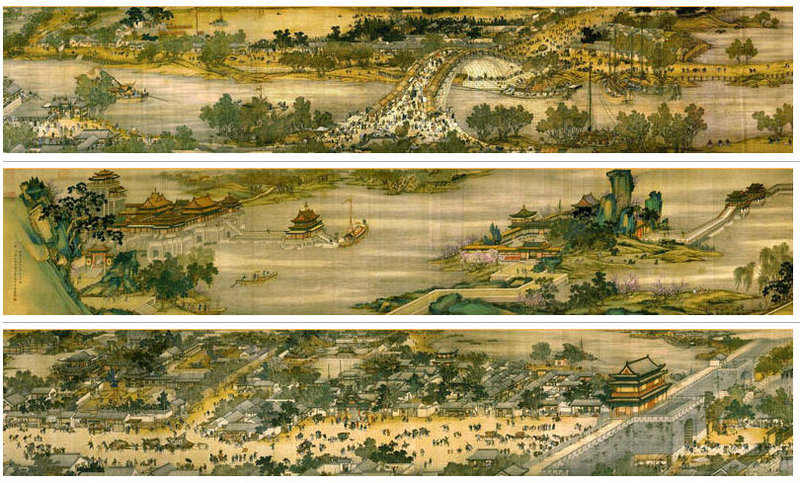
It was a 24.8 by 528.7 cm water color landscape scroll on silk created by artist Zhang Zeduan (1085-1145) of Northern Song Dynasty, This is not simply a scenic landscape painting but also a historical snapshot of the people and society from rich to poor as well as different economic activities in rural and the city area at that time. It captures the daily life of people from the Song period at the capital Bianjing, today's Kaifeng.. The painting is famous because of its geometrically accurate images of boats, bridges, shops, and scenery. Because of its fame, it has been called "China's Mona Lisa".
Like the Mona Lisa, the Qingming scroll was sold between numerous private owners before it finally returned to public ownership. The Qingming scroll is historically notable as one of the few paintings from the former imperial collection that remains in public ownership in mainland China; it was a particular favorite of emperor Puyi, who took it with him to Manchukuo and thus kept the Northern Song Dynasty original out of the collection of the National Palace Museum. It was later re-purchased in 1945 and is now held at the China Palace Museum in the Forbidden City.
The original painting has other later versions that copied the style of the original. One of the remakes was painted in Ming Dynasty (14 to 17th century). This remake has a length of 6.7 meters, longer than the original. It also replaced the scenery from Song Dynasty to Ming Dynasty. The clothing of humans, boats and carts in the remake painting show a wealthier city. The Song wooden bridge is replaced with a more modern stone bridge. The arc of the stone bridge is much taller than the wooden original, and where the original had a boat about to crash into the bridge, the reinterpretation has a boat being methodically guided under the bridge by ropes pulled by men ashore, several other large boats dutifully waiting their turn, undisturbed.
Another version from the Qing Dynasty (1736 version) by five Qing Dynasty court painters (Chen Mei, Sun Hu, Jin Kun, Dai Hung and Chen Zhidao) and presented to the Emperor Qianlong, was moved to Taiwan along with many other artifacts to the Taipei Palace Museum in 1949.
Several Ming and Qing versions can be found in public and private collections around the world. Each version follows the overall composition of the original fairly faithfully, however the details often vary widely. The Song Dynasty original and the Qing version, in the Beijing and Taipei Palace Museums respectively, are regarded as national treasures and are only exhibited for brief periods every few years.
If your internet access speed is high enough, you may click here to view the whole scroll, if you would like to listen to an accompanied music while viewing the scroll, please use internet explorer 6 or later ( I don't know why Firefox come out without music), if you can not read the Chinese text, no problem, it just remind you don't forget to turn on your speaker and have a cup of tea or coffee, relax and enjoy.
HOME FOOD FLOWER PAINTING ANOTHER WORLD Back to top